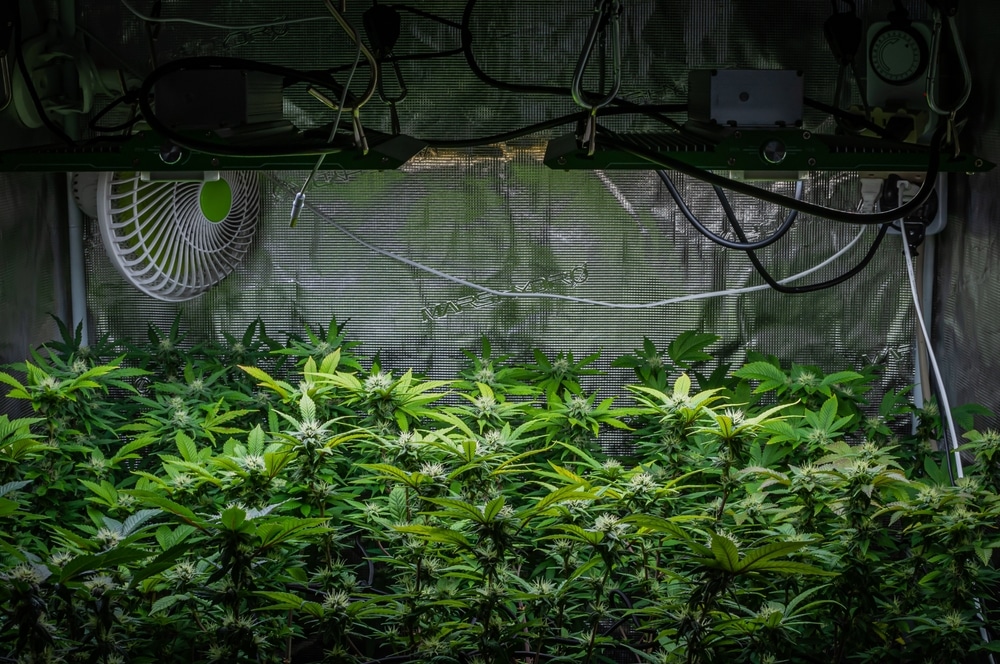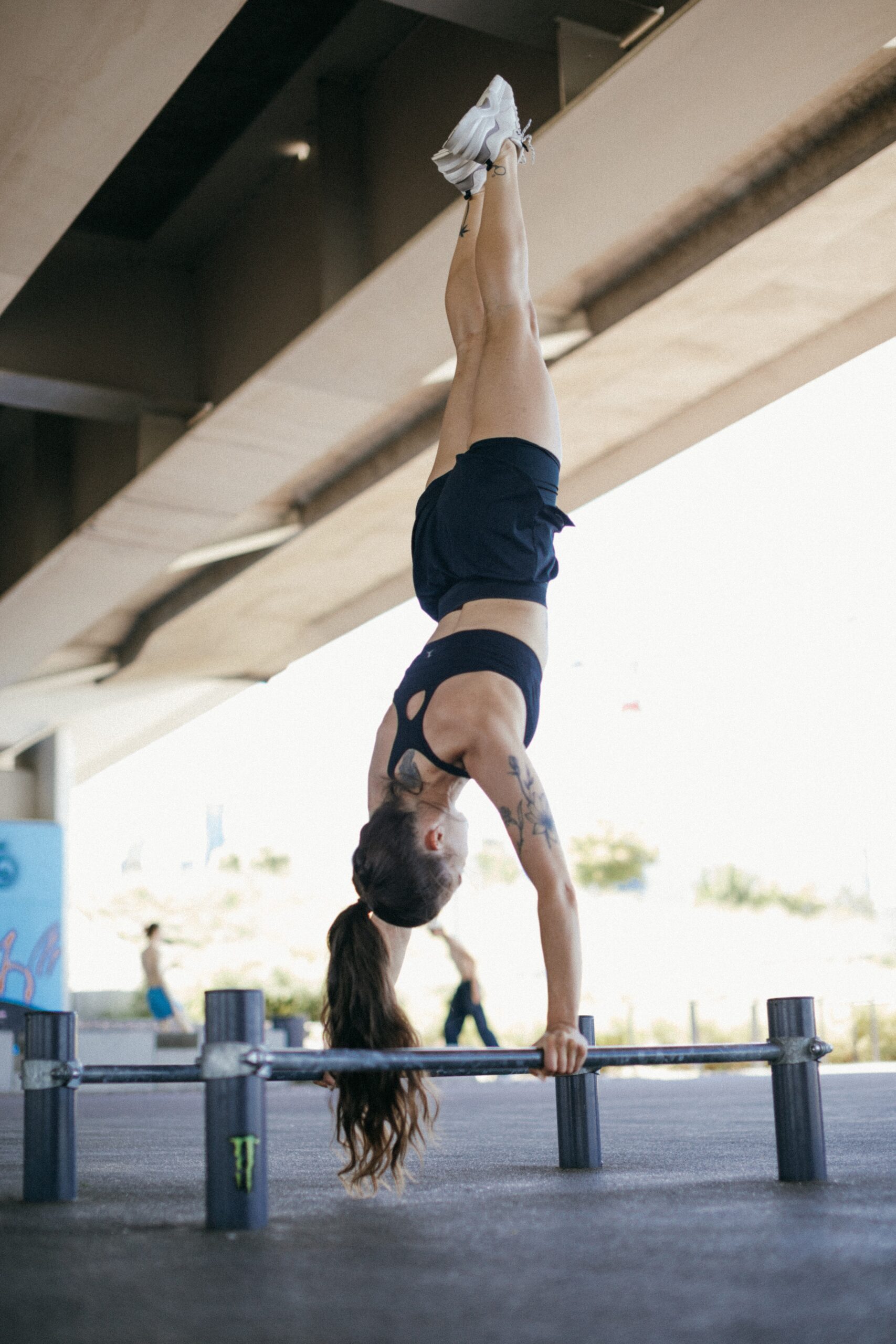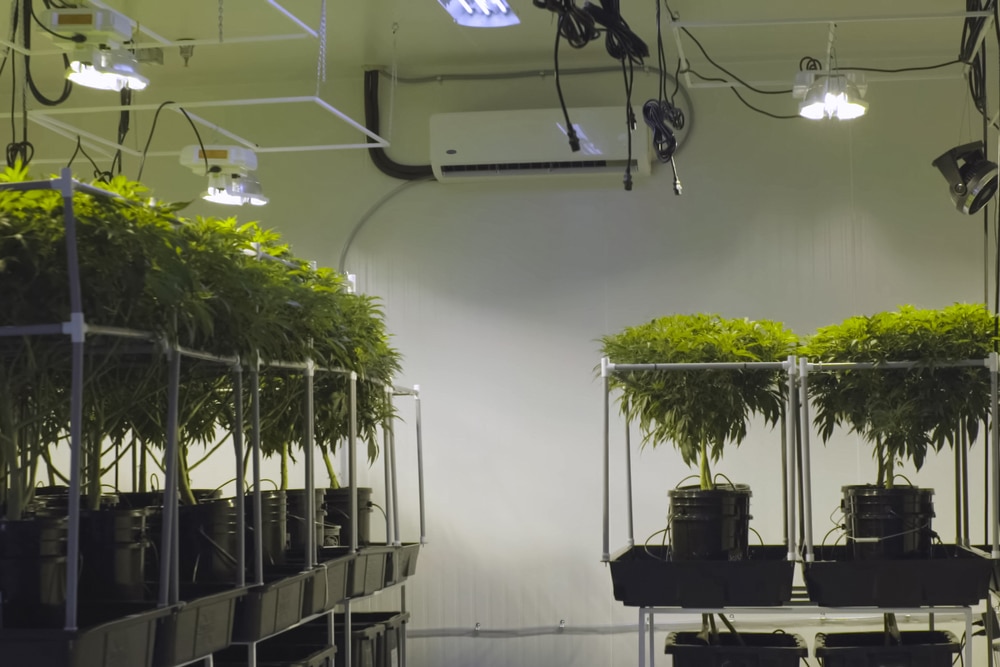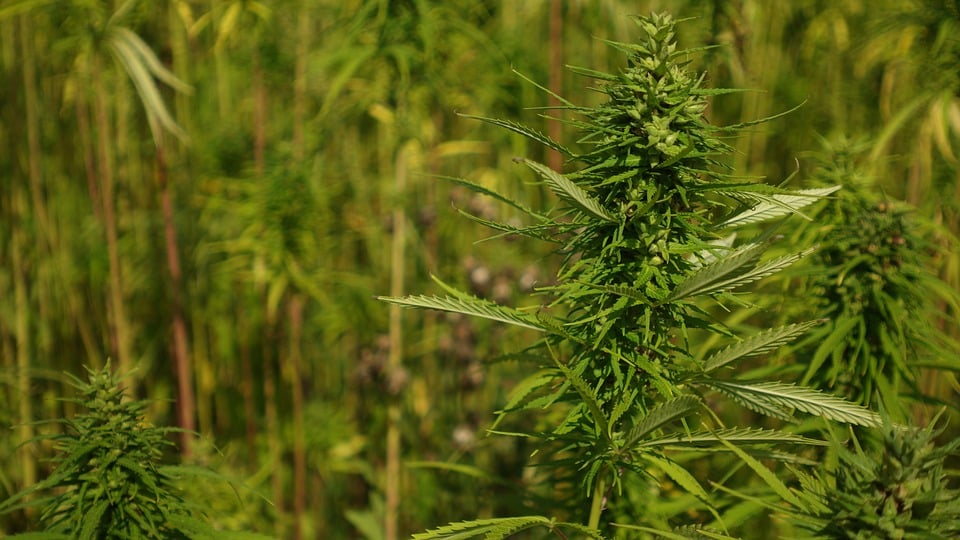No products in the cart.
Marijuana Education
Cannabis Grow Tent Setup
What makes the ideal cannabis grow tent setup?
It should suit your resources, requirements, and needs, while providing an optimal environment for your plants.
Using a grow tent allows you to provide your marijuana crops with a controlled environment covered in light-reflecting material. You control the air exchange, humidity, temperature, and illumination your plants receive.
Employ this cultivation method to produce healthy, beautiful, and top-quality buds. It simplifies the cannabis growing process, making it possible for beginners to produce spectacular results.
Why should you use a grow tent, and how can you set one up?
Let’s find out.
Why should you use a cannabis grow tent setup?
Growing healthy plants from cannabis seeds and obtaining high yields depends on various factors, including:
- Humidity
- Temperature
- CO2
- Ventilation
- Lighting
A grow tent may help you optimize these factors.
The mesh ventilation aids in locking out dust and other contaminants, and the tent shields plants from mold and pests.
The average grow tent costs around $70–150. It’s a simple and affordable way to set up a specialized growing area for marijuana.
Below are the benefits of cultivating your weed in this setup:
You manage the environment
When cultivating marijuana outdoors, you depend on the weather and other environmental factors. Using a grow tent setup means you don’t have to stress over difficulties like frost, excessive rain, or lack of sunlight.
You have complete control over the air, moisture, humidity, and grow lights.
Controlling the environment and practicing cleanliness inside the tent can also help prevent pests and other issues.
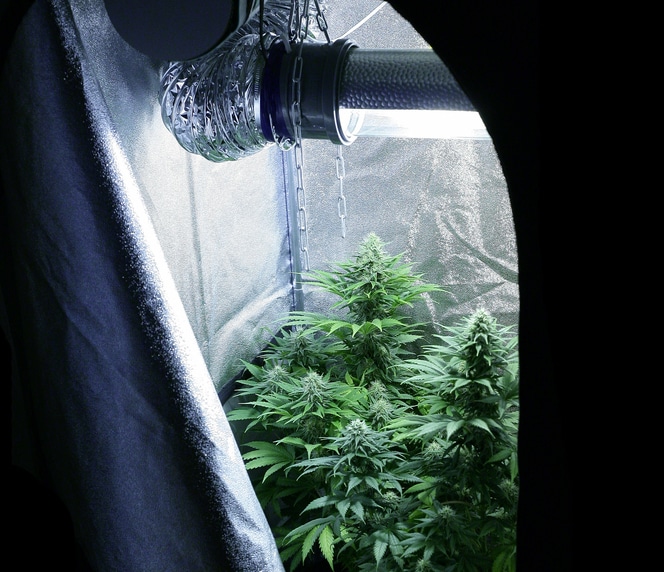
Increased privacy
Many states in the US have legalized marijuana for medicinal or recreational use. Some allow you to cultivate it in your home or garden, but despite these modern laws, there’s still some stigma associated with weed.
Discreet farming is an excellent option to avoid attracting attention to your weed-growing activities.
Cannabis has a strong smell when flowering, and people in your neighborhood might begin to notice if you don’t control it.
An odor-proof grow tent setup with good ventilation may protect your home from the smell. You can also add an intake fan inside and a carbon filter to your air vents to minimize the scent.
Simple to use
A marijuana grow tent is simple to assemble, much like one you use for camping. You can set everything up in a few hours with minimal effort; it’s quicker if you have friends helping you.
It’s also portable, allowing you to easily move it to a better location if complications arise.
Simple to take down or destroy
It’s sometimes necessary to be prepared for the worst, which might entail having to dismantle your indoor marijuana setup promptly.
A grow tent is simpler to remove, hide, or take down than a whole cultivation room. If necessary, you can replace it as quickly as you dispose of it.
Grow at any time
A grow tent setup allows you to cultivate throughout the year without worrying about the changing seasons. The correct lights produce enough illumination to mimic outside conditions, promoting photosynthesis and healthy plants.
Cultivating marijuana year-round allows you to generate more, so you won’t run out of fresh, harvestable buds.
How to set up your tent
Grow tents are some of the best tools for all-year-round indoor cannabis growth, and assembling the kit is simple.
The necessary tools typically come with the set, making it possible to arrange and attach everything easily.
Below are the materials you should have for assembling your indoor grow tent.
Grow tent
The vertical height of grow tents should be sufficient to accommodate your marijuana plants and other equipment. Consider these factors when choosing your kit, so your crop has extra space with no restrictions.
Grow light
Lighting is essential in growing tents, providing the energy necessary for your crops to digest nutrients and engage in photosynthesis.
By strategically positioning your lamps, you ensure your marijuana plants receive as much light as possible. Ensure they’re not too close to or far from the lamps; too much heat could burn your crop, while too little could result in a garden that doesn’t thrive.
Grow lights come in different sizes and shapes. Let’s examine the available choices.
- Fluorescent lights: Fluorescent lamps are suitable for seedlings and the early phases of your plant’s life, but they’re not the best for ongoing veg or blooming. They’re cheaper and provide less heat but may be bulky and result in smaller yields.
- HID lights: High-intensity discharge (HID) lamps are ideal for flowering and vegging. Use red-heavy sodium for vegetation and blue-heavy halides for flowering. They’re efficient and powerful but use more energy, produce heat, and may prove to be more costly.
- LED lights: In recent years, light-emitting diode (LED) lights have advanced remarkably. Their light spectrum is ideal for vegging and flowering plants, allowing you to provide daytime-like conditions and complete darkness for photoperiods.
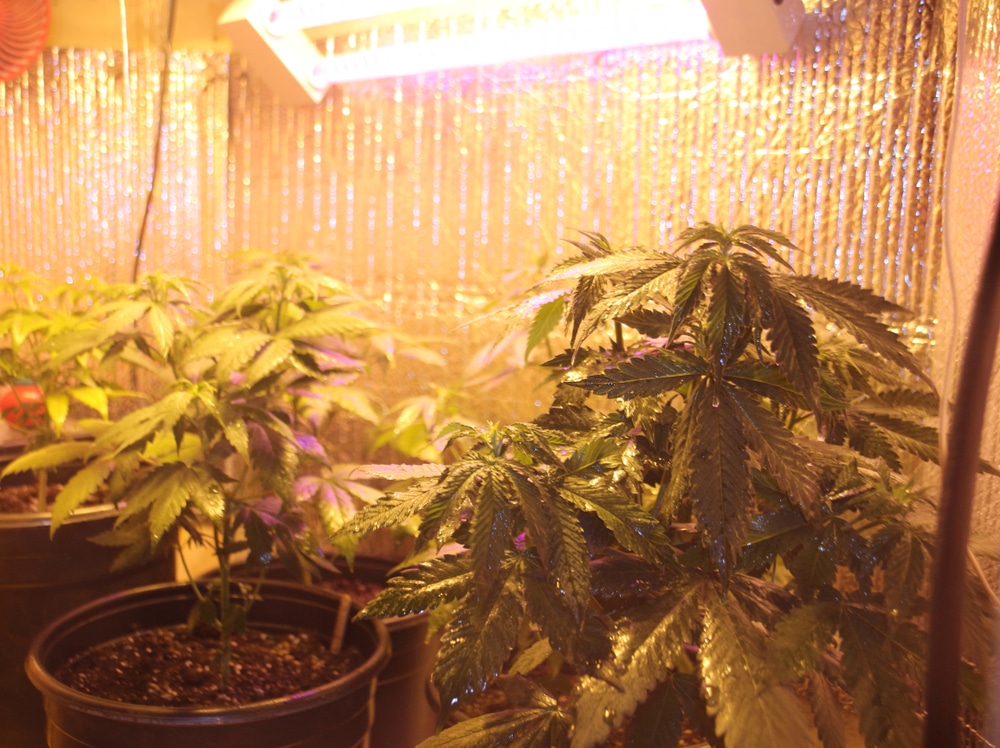
Ventilation
Ventilation prevents CO2 buildup, regulates humidity, reduces heat, and maintains an ideal temperature suitable for growing cannabis. It also aids in pest control and preventing diseases.
Grow tent ventilation produces cool air currents, helping the plants’ stems become more robust.
Use oscillating fans or an air extractor system in your grow tent setup to ensure your plants get the necessary ventilation.
Carbon filters
A carbon filter assists in purifying the air within the grow tent setup, removing unpleasant odors and infections that could harm the plants. It’s simple to install and only requires changing every two years.
Dehumidifier and humidifier
The humidity level in your indoor tent setup is crucial for growing cannabis.
You can implement a process called vapor pressure deficit, where you increase the humidity throughout the day and decrease it at night. Invest in a high-quality hygrometer to help you maintain these levels more easily.
Step-by-step guide on how to set up a grow tent
Now that you know everything that goes into the ideal grow tent, it’s time to set it up. Follow the steps below to create an efficient framework:
1. Pick a place for your grow tent
Choose a location that’s long-term, accessible, and stable. You want to avoid relocating anything during cultivation and ensure access to a power source to deliver the necessary energy.
2. Clear and clean the space
Clean the entire room: disinfect the walls, floor, ceiling, and windows to keep fungus and insects from harming your plants.
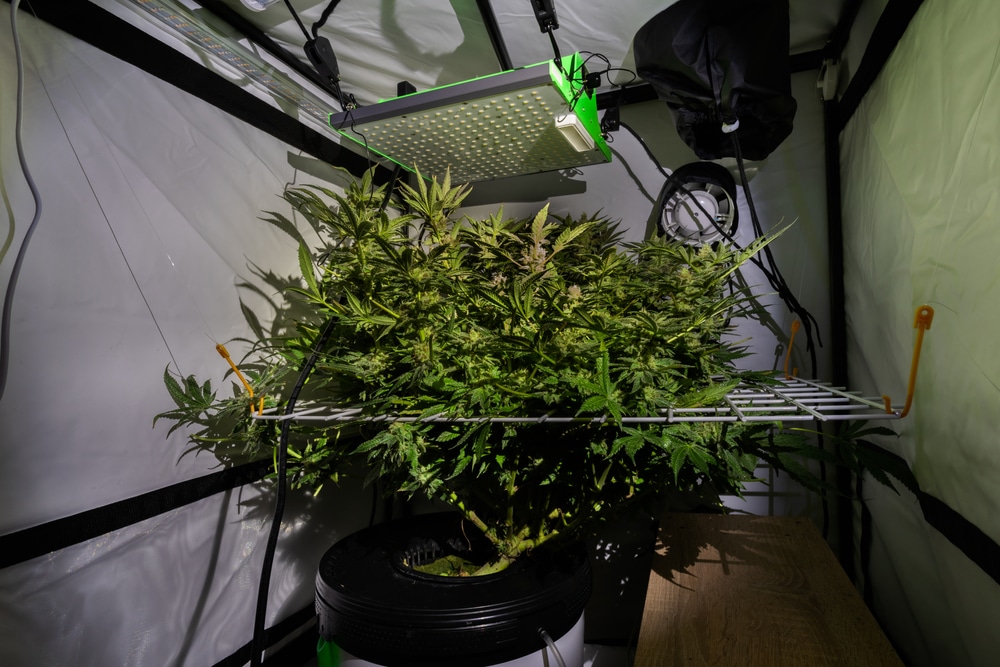
3. Assemble your equipment and install the tent
Follow the instructions that came with your kit to put it together. Assemble the frame before covering it with a heavy canvas or light nylon cover.
Verify that the tent zippers function correctly and that the seams are in good condition.
4. Install the grow lights
Fix the light holders. The majority of grow lamps include mounting hardware for securing tent crossbars. Ensure you follow those instructions to install the lights at the proper height for your plants.
Secure and organize your wiring system to prevent electrical accidents and ensure sufficient light-proof covering to avoid light leaks.
5. Setup the ventilation and a carbon filter
Choose a location inside the tent, like the crossbars, for your carbon filter.
Then, mount the exhaust fan, ensuring it oscillates toward the ventilation opening and exits through the carbon filter.
Install a ducting system between the exhaust fan and the carbon filter after measuring the distance between them. Connect the exhaust to the vent aperture in the grow tent. Ensure the electric cords can reach a power source.
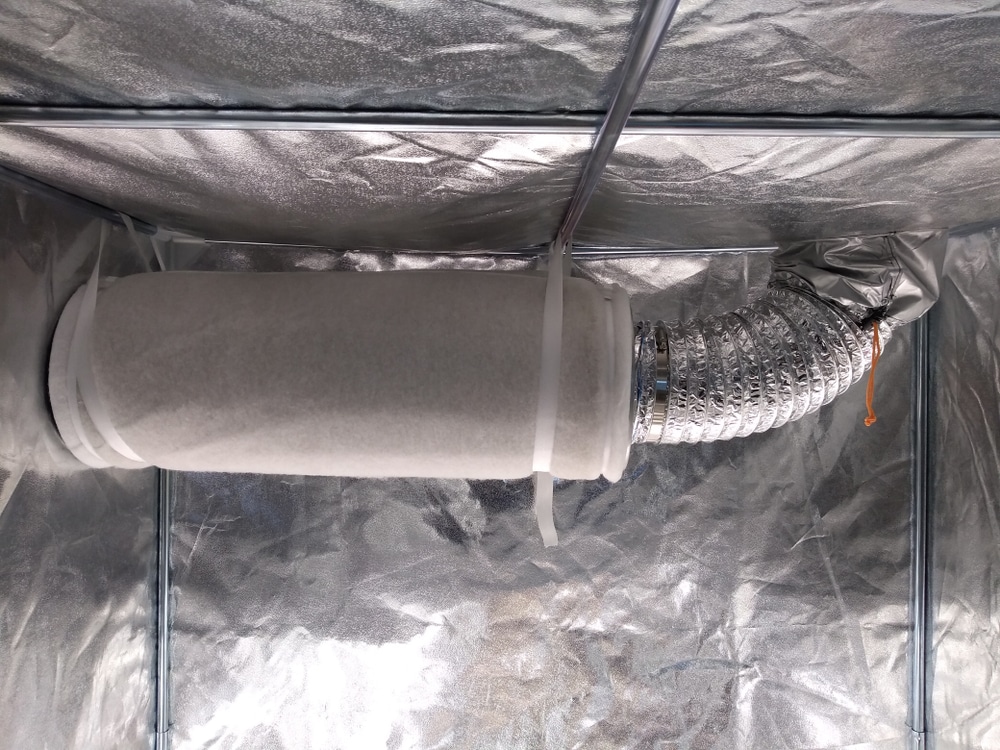
6. Install the thermometer and humidity gauge
Mounting the thermometer and humidity gauge helps you monitor and maintain an ideal growing environment.
7. Conduct a safety scan
A safety check ensures that all electrical cords are protected from moisture and out of the way to avoid accidents and other hazards in the future.
8. Grow your cannabis plants
At last, it’s time to begin growing marijuana after you’ve finalized and polished your indoor grow tent setup.
As your crops mature, you may need to adjust the humidity, temperature, and other elements, so remember to check on them constantly.
Selecting the best grow tent
The ideal tent depends on how many plants you intend to cultivate and what kind of lighting and ventilation you use.
Consider the following factors when searching for a grow tent:
Height
The lighting you choose is an essential determinant in selecting the size of your grow room tent.
You need taller tents when using an HID grow light setup, as they may get hot and harm your plants. Ensure you hang them high above your crop to provide enough wiggle room for the flowers to stretch.
LED lights are preferential for many growers as they hang low and run cool.
It’s also essential to consider whether there’s enough room for a carbon filter, exhaust fan, and taller plants when calculating your tent’s height.
Consider growing small plants if you have limited space to avoid potential problems.
Frame and weight limit
The internal structure of a tent determines its quality regardless of its intended use, price, and brand name. Look for durable corner joints and metal poles with a decent wall thickness. The CoolGrows tent is a fantastic option, providing high durability and heavy-duty material.
Ensure the tent can support the weight of your equipment, including lighting, fans, filters, and other tools.
Material density
The fabric density of entry-level tents typically ranges from 200–600 D (denier units). High-quality canvasses can reach a maximum of 1680–2000 D.
Denser fabric reduces light leaks that could cause plants to produce unwanted hormonal reactions. A sealed tent with additional thermal layers and reflective materials is ideal.
Ventilation ports
These 6–8″ ports are designed for exhaust and intake fans to maintain a constant flow of fresh air into and out of the tent.
Aim to have at least two ports if using an LED light system.
Ensure up to four ports if you have HID lights to handle the extra heat from MH or HPS bulbs.
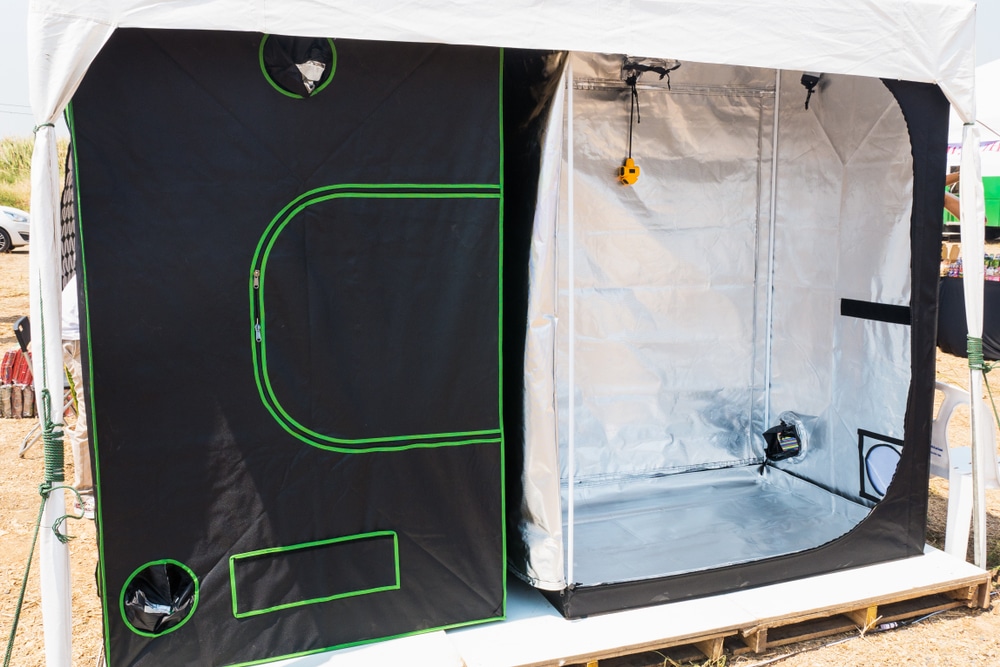
Irrigation and electrical ports
Some modern tent kits have 2″ ports that allow electrical wires to pass through, making it easier to manage the clutter of cables.
The more electrical connections are accessible, the easier it is to keep things organized.
If you implement a hydroponic system and set up the reservoir outside, you need extra irrigation ports to transport the water.
A hydroponic system can help supply a steady flow of water and nutrients to optimize crops for a perpetual harvest.
The number of marijuana plants you wish to grow
You need adequate space for growing weed plants to flourish in a relaxed, uncrowded atmosphere. You should also have sufficient room for your ventilation fans and lights.
Your preferred marijuana strain and growing techniques
Some cannabis strains need more grow room since they stretch into taller plants. You also need more area for some training techniques like Screen or Sea of Green. A too-small tent setup with limited space can cause problems, so ensure you get one that’s big enough.
How much space is necessary for the grow tent?
Consider starting with a smaller tent and fewer plants to help you learn the ropes if you’re a first-time grower. The ideal size should accommodate high-yielding crops of indoor marijuana and fit well within your home or garden.
Grow tents are typically sized in square feet to indicate the base’s size. The most popular grow space size is 2’x4′ (length by width), while some growers choose 4’×4′ or 3’×3.’
Each model has a different height, so ensure you pick the right one depending on how tall you expect your plants to grow.
The tents should be large enough to allow your plants to develop properly. Fewer plants mean less chance of mistakes and less time spent maintaining them.
How many marijuana plants can fit in a grow tent?
Your cultivation methods and specific strains determine how many plants will fit in your tent.
The following plant training techniques can be beneficial to ensure optimal growth.
ScrOG method
Growers use the Screen of Green (ScrOG) training method through a net or mesh to maximize horizontal space. It can help you achieve two to three times the yield from grow tents than you would with conventional cultivation techniques.
Cover as much of the grow tent as possible as the branches grow through the net, ensuring they receive the most light possible.
ScrOG crops develop bigger buds and a bushier structure. They’re uniformly dispersed throughout the netting, helping to distribute resources across the entire plant.
As a result, you receive evenly spaced colas across your grow room. SCROG works well with all setup sizes but excels in mini tents. Sativas are best suited to this method.
Sea of green method
The Sea of Green technique involves packing many little plants closer together. It encourages faster vegetative growth, enabling you to harvest as soon as possible.
Grow one or two weed plants per square foot to give them enough space. Your crops will be short, but you can obtain a respectable yield in a short tent. Indicas are best for this method.
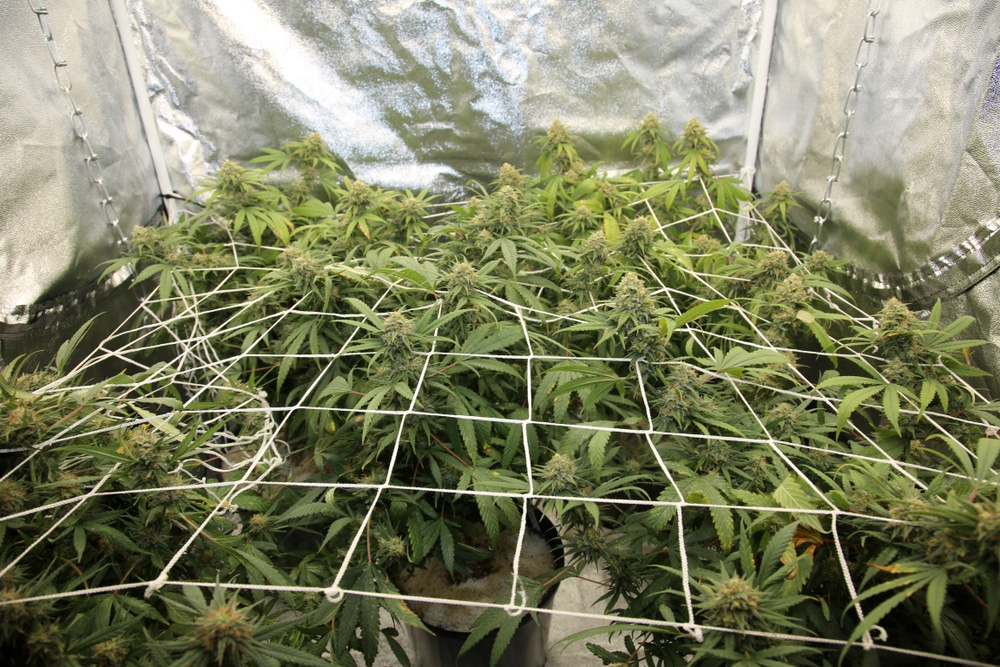
LST method
Bending the branches during low-stress training (LST) helps to spread light evenly across the canopy. Delicately manipulating the plant’s stems exposes it to more illumination to encourage bigger, fatter buds.
LST is most effective when you spread one cannabis plant every two square feet. Use wires, twine, or gardening protective wire to connect branches to the pot’s edge after bending them in various directions.
How tall will the plants get?
Your marijuana grow tent should be comfortable to enter and exit while caring for your crops. Its height also significantly affects how it functions.
If you’re growing marijuana indoors, indica strains are bushier, shorter, and ideal for smaller spaces.
If you plan to grow sativa strains indoors, it’s advisable to choose bigger products like a Gorilla grow tent. It’s tall, has sturdy steel poles, and is generally equipped with height extension kits.
Remember to suspend the grow lights at a safe distance from the plants. Factor in a few extra inches of height, or buy tall tents to accommodate them.
Multiple tents or more chambers?
Many seasoned marijuana producers prefer to set up two or more tents, providing separate spaces for vegging and flowering plants.
You can then use a different one to dry the last harvest.
Some grow tent manufacturers offer tents with several chambers that are separate from each other. They allow you to house larger plants in one central section while growing seedlings and clones in smaller ones.
Correctly timing your use of a multi-chamber tent can help you achieve a perpetual harvest throughout the year. While you have blooming cannabis in the flowering chamber, you can sow fresh seeds in another.
Choose a grow tent for vegetation and flowering
When plants are at their largest during the flowering cycle, you need a durable tent to hold them.
Flowering grow tents are wider and taller than those used only for vegetative plant growth. Depending on environmental factors and the species you’re cultivating, plants can grow twice as large in the first two weeks of blooming.
For this period, also known as “the stretch,” growers allow themselves as much flexibility as they need.
A plant’s bud sites require sufficient breathing space, so extra room between colas promotes better airflow. It helps fight against pests like spider mites and common diseases like botrytis and powdery mildew.
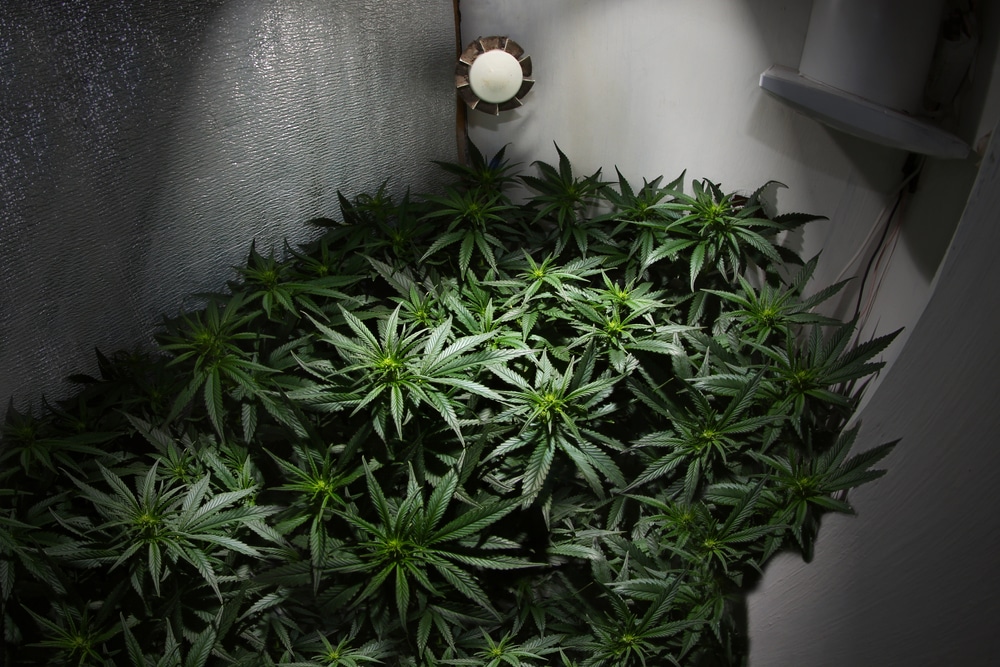
How to maintain your indoor cannabis grow tent
After erecting your grow tent and starting cultivation, regular maintenance is essential:
- Ensure the grow tent is in good shape to prevent the frame from collapsing.
- Verify that it’s light-proof to limit leakage.
- Confirm the tent’s air-tightness to help reduce the marijuana scent and keep outsiders from smelling it. Carbon filters are your best bet for odor control.
- Ensure it has a proper ventilation system and constant access to carbon dioxide for the plants to convert to oxygen and carbohydrates. Good airflow and enough space also promote even temperature distribution, resulting in healthier crops.
- Check regularly for leaks, ensure there aren’t any wires hanging loose, and install a waterproof floor to avoid potential mold issues.
Things to avoid doing in a grow tent
Several things growers may do can directly injure your plants or grow tent. Avoid the following to prevent problems:
Never relocate a tent that still contains plants or equipment
If something goes wrong during relocation, you risk tearing the fabric, rendering the tent permanently useless. Objects could also fall on your plants and damage or break them.
If you want to reposition it, remove everything, move it, then replace the plants and equipment.
Don’t leave your plants unattended for more than two days
Missing one day isn’t a huge deal, but you must pay careful, frequent attention to your marijuana plants. Problems can spread quickly in a confined space.
If any issues arise, you need to be around to address them promptly and prevent them from getting worse.
Don’t eat or leave food scraps in the tent
Watching your plants grow is a fun, rewarding experience, but you can’t treat it like watching TV or relaxing by the pool.
Some human foods aren’t good for your plant, so don’t bring any into the grow tent. They can attract pests and create favorable conditions for fungi.
Composts need a special container and plenty of time for the organic material to break down and become useful, so keep them separate from the tent and preferably outside.
Keep outdoor equipment outside the tent
Everything typically kept outside should stay there, so you don’t risk bringing pests and fungi inside.
Optimal grow tent environment = Optimal harvests
Now that you know everything about cannabis grow tents, it’s time to let the fun begin.
Remember to plan ahead by understanding specific strain requirements and purchasing the correct equipment.
Providing an optimal environment for your crops goes a long way in reaping abundant, high-quality yields.
Visit The Seed Fair to purchase high-quality seeds and learn more about cannabis cultivation via our resourceful blog.
FAQs about grow tents
Still got questions about cannabis grow tents, LED grow lights, or the safety of your setup? Find the answers below.
Are grow tents worth it?
A grow tent may initially seem like an expensive investment, but it could be highly profitable. It can help you frequently harvest in optimal conditions when growing cannabis indoors, ensuring a steady supply.
It requires more technology to maintain airflow and regulate humidity and temperature, so determine whether you can afford it before getting one.
How safe are grow tents?
The area around a grow tent is generally safe, but there are a few factors to consider inside. Ensure there are no leaks or loose, exposed electrical wires.
Pay attention to the quality of the tent’s canvas. Avoid purchasing inexpensive plastic ones made of PVC or polyurethane, as they could leak harmful chemicals into your crop.
Plastic tents may also burn up very quickly in an accident. High-quality ones are made of dense cloth instead.
Do grow tents retain odor?
Yes, cultivating cannabis in grow tents is beneficial for odor control. The most effective way to manage the smells inside is by attaching carbon filters to the exhaust fans.
Should I keep the fan running after turning out the lights?
You can still run your oscillating fans after switching the lights off. Shut down any other fans about an hour after dimming the room. An automation feature can help you save energy and time.
How many plants can a 600w LED grow light support?
The size of your tent area and plants determines the strength of your lamps. You can place up to six plants below a 600W LED in a 4’×4′ tent, and a single 300W is sufficient if you’re only growing one plant.


